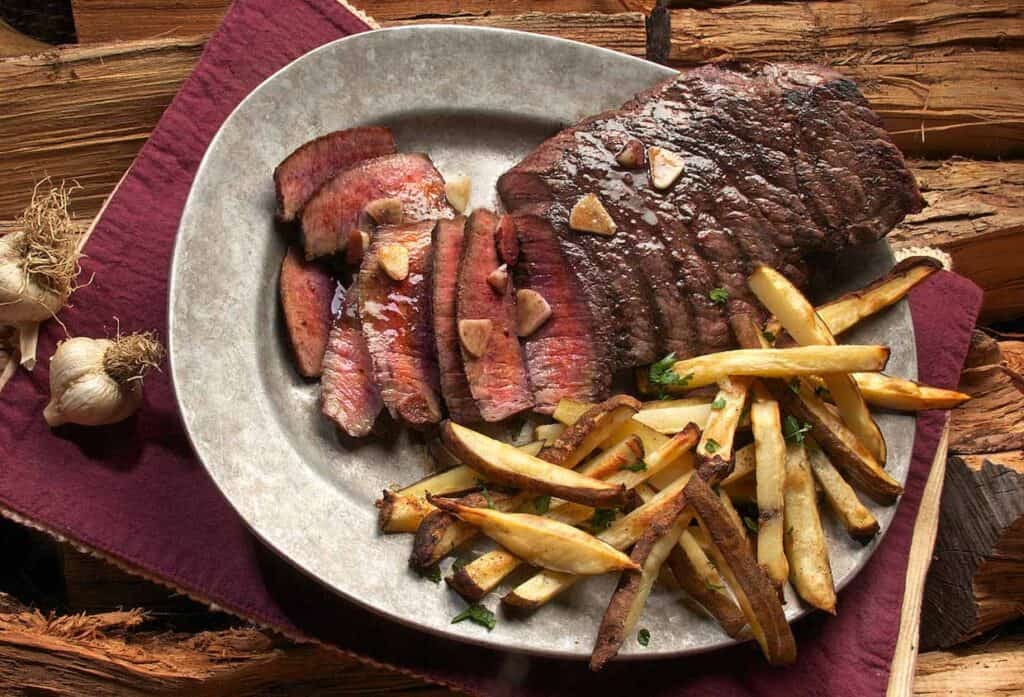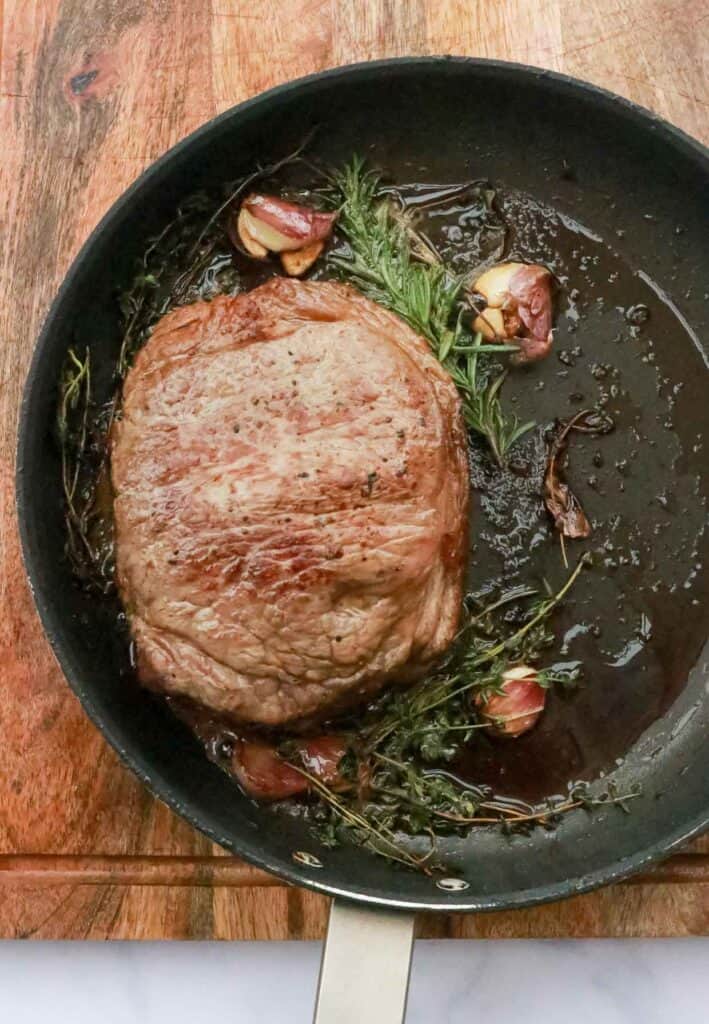Steak lovers know that the perfect steak is hard to come by. Traditional methods, like open-flame grilling, can make it hard to control the finished product due to swings in temperature.

Thankfully, the reverse sear method has recently gained popularity to save the day. This game-changing yet simple technique involves cooking the steak low and slow before giving it a quick sear, resulting in a juicy, tender and evenly cooked piece of meat.
This article will demonstrate how to reverse sear a steak like a pro and why it’s the ultimate way to elevate your steak game.
Selecting the right steak for a reverse sear
Reverse searing can be done with almost any type of steak whether it’s an expensive filet or a cheaper cut of meat like a top sirloin. However, thicker, well-marbled (higher in fat) steaks are often chosen for this method.
When buying steaks to reverse sear, look for a cut with a minimum thickness of 1 ½ to 2 inches.
Optimal steak cuts for reverse searing include:
- Ribeye
- Filet mignon
- New York strip
- Tri-tip
- T-bone or Porterhouse
The options aren’t limited to just steak, however. Reverse searing also works exceptionally well with beef roasts like tenderloin, prime rib and eye of round.
While thinner cuts of steak could theoretically be reverse seared, there’s a higher potential to overcook them and it’s not worth the time involved. Save those steaks for the grill or quick and easy stir-fries. Sheet pan steak and shrimp fajitas are perfect for those thin steaks.
Preparing the steak
To prepare the steak for the reverse sear method, start by seasoning it generously with salt, pepper and any other desired herbs or spices.
Place the steak on top of a wire rack set on a rimmed baking sheet and let it rest uncovered in the refrigerator for at least half an hour up to overnight. The resting period helps to draw out moisture creating a better crust on the steak in the end.
“I love to reverse sear any thick cut of steak. I find that it ensures my meat is more evenly cooked and turns out juicier than any other method I try with the perfect crispy crust on the outside every time. Try placing your uncooked steak on a wire rack in your fridge the night before to magnify the impact, too.”
— Michelle Price, Honest and Truly

The reverse sear process
With normal grilling, a steak would be placed on a preheated grill and the sear would happen first while the inside of the steak cooks secondarily. With the reverse searing method, the opposite occurs.
There are two parts to the reverse sear process:
- Slow cooking
- Finishing with a sear
Slow cooking the steak
The slow cooking part of the process can be done either in the oven (most common) or on either a gas or charcoal grill over indirect heat.
If choosing the oven, preheat to anywhere between 225 F to 275 F. Transfer the seasoned steak on the wire rack and baking sheet into the oven on the middle rack. Cook the steak until the internal temperature reaches 10 F to 15 F below the desired doneness.
For example, a medium-rare steak’s final temperature should be 130 F. Therefore, when reverse searing a steak to medium-rare, it should be pulled from the slow cooking process at 115 F to 120 F.
FDL’S 75 Best Bites

Our cookbook with 75 tasty recipes will be your go-to kitchen companion for easy dinners with ad-free recipes right at your fingertips. Crafted by experienced chefs and recipe developers, this collection offers a treasure trove of tried-and-true dishes that make mealtime a breeze.
Get the Recipe: FDL’S 75 Best Bites
The same process should be followed when slow cooking the steak on a grill instead of in the oven.
The grill must be set up for indirect cooking. This means on a gas grill, half the burners would be turned off and the steak placed on the side without the flame. For a charcoal grill, the charcoal would be pushed to one side and the steak placed on the opposite.
Pro tip: The key to a successful slow cook is having an instant-read meat thermometer handy. The process will take a bit longer than traditional grilling since the steak is cooked at such a low temperature. For 1 ½-inch steaks, start checking the temperature around the 25-minute mark.
Searing off the steak
When the steak is 10 F to 15 F below the desired level of doneness and just pulled from the oven, it will likely look pretty gray and unappetizing. This is the point where the reverse sear method shines.
Like the slow cooking process, the finishing reverse sear can be done either on the stovetop in a cast iron skillet or on the grill over direct heat.
For stove top searing, place a tablespoon or so of either butter or a high smoke-point oil in a cast iron skillet over high heat until almost smoking.
Carefully place the steaks into the hot skillet and sear for about one minute per side until golden brown. Use tongs to sear the sides of the steaks as well.
“Reverse searing ribeyes on my cast iron skillet is always a foolproof way to achieve steakhouse-quality results at home. Taking the time to gently cook the meat before giving it a quick sear results in a tender and juicy steak with a perfectly caramelized crust.”
— Sara Nelson, Real Balanced
To sear on the grill, first, remove the steaks from the grill after the slow cooking process. Turn on all the burners to high or build up the biggest charcoal flame possible then cover the grill and let it preheat until it reaches its peak.
Once hot, place the steaks back onto the grill and turn frequently until crisp on all sides. This should take about one to two minutes in total.

Serving the steak
A reverse-seared steak does not need resting time. It’s ready to be served immediately. However, it’s important to know how to properly slice the steak for the most tender result.
Although not specific to reverse searing, almost any steak will benefit from cutting against the grain when serving.
Whether cutting tri-tip steak with its confusing two-directional grain pattern or a simpler flank steak, slicing against the grain results in a more tender bite making the steak much easier to chew.
Pros and cons of the reverse searing method
While the perfectly cooked, rosy center might have you thinking otherwise, there are a few downsides of the reverse searing method worth mentioning.
- Takes longer than traditional grilling methods
- Doesn’t work well for all cuts of beef
- Harder to make a sauce from
The last point is because there isn’t significant buildup in the pan after the quick reverse sear. While that’s great from a clean-up standpoint, that buildup, known as “fond,” is typically the base of a delicious steak sauce.
The good news, however, is that a reverse seared steak is packed with so much flavor (all those brown bits that would typically be in the pan stay inside the steak instead), it certainly doesn’t need a steak sauce to shine.
The benefits of reverse searing are simple yet powerful:
- Perfectly cooked steak each time
- Better browning on the outside
- More tender meat
Go forth and sear
Now that everything you knew about cooking a steak has been flipped on its head, hopefully, the intrigue of reverse searing has set in. It’s a worthwhile cooking method to try out if time allows. The results will speak for themselves with the first bite of flavor-packed, tender steak.
Gina Matsoukas is the photographer, writer, and recipe creator of Running to the Kitchen. Focusing on healthy, seasonal, whole-food recipes, her work has been featured in various online and print publications including Food Network, Prevention Magazine, and Women’s Health. Gina lives in central New York where she enjoys an active outdoor life.